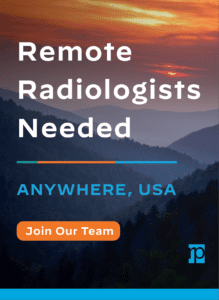Dr. Woughter shares how RP provides opportunities for growth, leadership development and collaboration, while maintaining a healthy work-life balance.
Dr. Meghan Woughter is a breast radiologist in Houston, Texas. She is a member of the Society of Breast Imaging and the Radiological Society of North America. Outside of work, she enjoys spending time with her husband and two young sons. Her family enjoys traveling and taking annual trips to Disney, and she and her husband recently were scuba-certified and have gone on several dives together. She joined RP in 2020.
We talked to Dr. Woughter to learn more about her radiology career and why RP is the right fit for her.
Tell us about why you got into radiology.
For me, it was kind of a slow process through medical school, figuring out what I liked and what I didn’t like. I think it started in anatomy lab, just seeing the correlation between the radiographs and imaging and some of the real-life cadavers – the different things we were learning about anatomy. I realized in radiology, I would touch every facet of medicine and take part in the diagnosis and treatment of all kinds of different patients if I wanted to. That really appealed to me.
Why did you pursue breast imaging as a subspecialty?
There were a lot of people along the way who shaped my decision-making. Most recently, when I decided to go into breast imaging, I had the fortune to train under Dr. Deborah Monticello at Texas A&M, who was instrumental in my understanding of breast imaging and showed me what an excellent physician and caregiver looked like. For me, breast imaging is a combination of multiple aspects I really like, including focusing predominantly on women’s health coupled with the actual clinical work. Every single day at work, I see patients in clinic, do biopsies in real-time and take care of them, in addition to doing all the imaging.
How did you connect with RP?
It was kind of unexpected. I finished breast fellowship in June 2020 in a very uncertain time in the pandemic, especially for breast imaging. A lot of breast centers had closed, and it was a scary time all around. I actually had a job lined up for a while, even before fellowship. It was up north (I’m from Texas), far from home and family, but at the time we thought, “No big deal. Three-hour plane ride, three-hour car ride; what’s the difference?” And then, of course, the pandemic hit, which really changed our perspective – we wanted to be close to family. In April 2020, when all the breast centers were closed, I decided to look for a new job where I was doing my fellowship in Dallas. I reached out to local contacts and was connected with an RP recruiter who asked, “Have you ever thought about Houston? Would you be willing to go there?” It was a whirlwind and totally meant to be, because within a week of talking to the recruiter, then talking to our practice president Dr. Khanh Huynh and doing virtual interviews, I was signing a contract and coming to Houston. It was great, and it has worked out better than I could have ever imagined.
What are some of the unique features that RP offers that are hard to find elsewhere?
Everything at RP is very practice-dependent, which is one of the things I like, because we’re all unique in our individual local practices and how we operate in our local practice’s culture. The culture of my practice is amazing, and the people I work with are amazing, so I have nothing but good things to say about my group. Since joining RP, one of the things I’ve seen is the ability to collaborate with other practices. There are several RP practices in Houston, and previously, our practice was in a position where we could help another local practice with radiology coverage. It was seamless because we’re all working under RP; we’re different groups, but we could come together like that, and I think that is a really nice example of the benefits of RP.
When I first started at RP, one thing that stands out is the leadership development opportunities. RP will connect new physicians with a mentor or encourage you to serve on some of the different physician support boards. I got involved with the Advocacy Support Board, where we advocate for radiology’s role in the broader U.S. healthcare system. As a relatively new physician coming into practice, this has opened up a great opportunity for me and an experience at my level that wouldn’t have been available to me, but RP really mindfully tries to help develop people in areas where they have an interest. It’s also been amazing to get to work with Dr. Rich Heller, Associate Chief Medical Officer for Health Policy and Communications, who is such a wealth of knowledge. When we gather for meetings, he’s on top of everything new that’s happening in Congress and what bills are passing, which helps everybody stay informed to then pass that information on to our local practices. Having him as a mentor and as someone to watch and learn from has been a really great opportunity. Later this year, we’re planning to visit Washington, D.C., to meet face-to-face with some of these congressional officials and advocate for our specialty.
How has the field of radiology evolved since you first started your career and what does the future of radiology look like to you? How will RP contribute to that?
I haven’t been practicing a long time, but in breast imaging, we’ve seen tomosynthesis (3D mammography) become a standard of care. There’s always new technology on the horizon. What I’m most excited about for the future is AI and what that’s going to look like for how we practice radiology. I foresee it as something that enhances our ability to read studies, care for patients and do things in a timely way. I really look forward to having that as something to build on for the future, and hopefully RP’s size and resources will allow us to utilize that and become early adopters.
You mentioned being excited about the future of AI. In the past, there has been skepticism about the role of AI in healthcare; has there been a recent tangible shift from skepticism to excitement about AI, especially in radiology?
I think there was a pivotal moment for me when I was in training because that fear and that saying, “stop training radiologists” definitely hit home. Later, I went to a conference, and a speaker put up this brilliant meme that said, “It’s not man versus machine; it’s man versus man with machine.” That’s exactly it. It’s not like we’re not sending pilots up because there’s autopilot on the plane; it’s just an enhancement. AI is a way to improve safety and outcomes for patients. I don’t foresee that they’re not going to have a radiologist who ultimately looks out for patients and has clinical judgment. As we’ve seen, people aren’t perfect, and the machines aren’t perfect, but hopefully together we’re going to make something that is safer and more consistent for our patients. I see it doing nothing but hopefully enhancing what we currently do.
As a full-time, busy radiologist and parent, how do you find work-life balance, and how does RP support you in this?
One of the things I loved about breast imaging and one of the things that drew me to it – in addition to everything else – was the fact that it’s clinic hours. I don’t have call, and I don’t work nights or weekends. I’m home with my kids on those days. This is in addition to loving the work, so it’s a win-win for me. Also, I think our local practice values listening to us about our needs. Once it came up there were several of us in the breast section who wanted to work more part-time, and the practice actually rearranged things and hired another rad to make it happen. Some people went to 80%, some went to 90% and some stayed at 100%. That was something that our practice did because that’s what we said we needed so we could have more time and balance.
Dr. Meghan Woughter (Twitter) earned her medical degree from Eastern Virginia Medical School in Norfolk, Va.; completed her residency at Texas A&M Health Science Center College of Medicine/Scott & White Healthcare in Temple, Texas; and completed her fellowship in breast imaging at University of Texas Southwestern in Dallas, Texas.
Radiology Partners, through its owned and affiliated practices, is a leading physician-led and physician-owned radiology practice in the U.S. Learn more about our mission, values and practice principles at RadPartners.com. For the latest news from RP, follow along on our blog and on Twitter, LinkedIn, Instagram and YouTube. Interested in learning about career opportunities? Visit our careers page.






